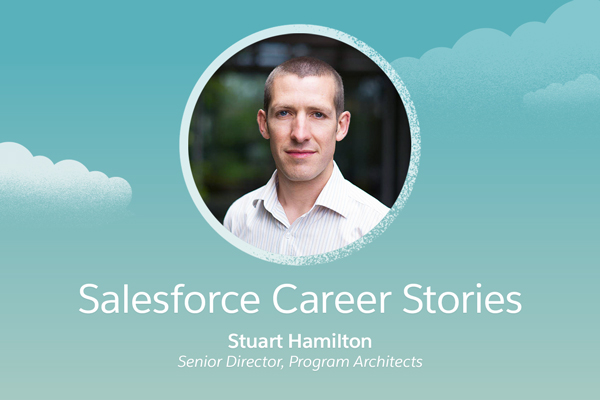Natural curiosity, a passion for learning, and keeping a beginner’s mindset — these are some of the traits that make an architect successful at Salesforce. During this Q&A, you’ll hear from Stuart Hamilton, Senior Director of our Program Architect team in Sydney, Australia. He shares his journey to Salesforce and how architects are blazing new trails to success with some of Asia-Pacific’s largest enterprise customers.
How did your Salesforce adventure begin?
I first became passionate about technology while keeping out of the rain during my 11th English “summer”, teaching myself to program a Sinclair Spectrum. After a little more schooling and a degree in Mathematics, I joined the world of enterprise software and spent 15 years implementing and integrating complex systems before joining Salesforce, a company I saw as changing the world of business technology.
I’m a techie from way back, and I’m also fascinated by understanding how businesses work — what makes them successful, what are the critical levers, and what part technology plays in all of this. Salesforce has awesome technology, streets ahead of the CRM competition. To get the most from the platform, customers need to adapt; to take a different, more agile approach to IT.
Tell us more about your role and how Architects help solve problems for our customers.
Salesforce has grown extremely quickly since I joined in June 2012, and the biggest challenge for Salesforce customers with ambitious, transformational goals is to find the right people with the right experience to make the right architectural decisions.
That’s the gap the architect fills: we use the whole Salesforce Ohana to bring best practices from around the world to our customers. As part of that, we’re also building that architect skill set for the Salesforce ecosystem — I have a whole team of future CTOs and CIOs building their own Ohanas of Salesforce-savvy technologists.
The architect’s role is to get deeply embedded with a customer, to really understand the business and then provide prescriptive technical advice on how get the best out of the Salesforce platform.
What do you look for when you hire? What makes someone successful here?
With continuous innovation, major acquisitions and three platform releases every single year, there’s always something new to learn in Salesforce technology. Successful Salesforce architects have a natural curiosity, a passion for learning and keep a beginner’s mindset, no matter their experience. Our architects are strategic advisors to some of the largest enterprise companies in Asia-Pacific, so the role is a great blend of technology depth and business strategy expertise.
What does a typical day look like for a Program Architect?
A Program Architect’s day will typically be at the customer’s offices, working directly with the customer’s team on their highest value priorities. Those priorities vary widely between customers and even day-by-day, but might include running a workshop on Salesforce integration or security practices, sharing feedback on a design for a specific platform solution, or meeting a technology leader to share advice on how to operate differently to deliver faster.
How would you describe the day-to-day relationships you have with your leaders, managers, and teammates?
Our team spends the majority of their time onsite with our customers, so day-to-day we do a lot of virtual meetings, IM and Chatter, then we use Volunteering and Ohana (=fun!) events to get together in person. For a company with 30k+ employees, the transparency at Salesforce globally is incredible — we get direct insight and input into major strategic decisions in a way that I haven’t seen in any other company of this size.
What apps, gadget or tools can’t you live without?
I do at least half of my work on my phone, and I’m a massive convert to Salesforce Quip for all my to-do lists and shared note-taking. Quip is a living document that’s 100% cloud-based and combines documents, spreadsheets, task lists, chat, Live Apps, and CRM data in one seamless experience. It allows our team to communicate from anywhere on any device!

Why Salesforce, why now?
I have a deep belief in the power of technology to change the world, and Salesforce is playing a huge part in that. I love that my personal passion matches the core objective of the business and that Salesforce then multiplies that into the community through the 1-1-1 model and the public support for equality. I’m proud to tell my daughters about the difference Salesforce makes to the world.
Quick facts about me:
- British born, in Australia since 2001. Married with two daughters at primary school.
- Racing cyclist; charity cyclist; Club Captain, Sydney Uni Velo cycling club
- Volunteer Judge for FIRST Lego League
Are you looking for a new challenge? We’re hiring across Asia-Pacific! Click here to find your perfect role.
Transform your everyday.












